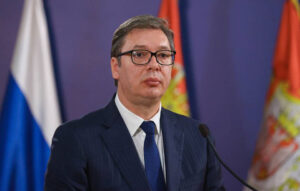
At the end of 2025, 56.2% of Ukrainians believe that the country is moving exclusively or predominantly in the right direction, while 30.6% assess this movement as wrong, according to the results of a nationwide sociological survey by Active Group, presented at a press conference at Interfax-Ukraine on Monday.
According to the published data, among Ukraine’s main achievements since the start of the full-scale invasion, respondents most often cited the attraction of international aid (61.4%). Respondents also noted the organization of the country’s defense (43.1%), the unification of society around support for defenders (32.8%), and the development of the domestic defense industry (32.6%).
At the same time, Ukrainians consider corruption to be the key internal challenge, with 79.2% of respondents naming it as the country’s main problem. Among other problems, respondents pointed to mobilization (39.7%), economic support (32.2%), and defense organization (33.7%). At the same time, 41.7% believe that the real fight against corruption has intensified, while 47.3% say it has weakened.

“Ukrainians are approaching the end of the year with a combination of cautious optimism and a demand for justice, which is why corruption remains the main internal challenge for society,” said Alexander Pozniy, director of the research company Active Group, commenting on the results of the study.
The survey also showed a high level of support for the idea of peace talks: 78.0% of Ukrainians view negotiations to end the war very or somewhat positively. At the same time, views on the terms of peace remain ambiguous. Thus, 46.5% admit the possibility of a temporary loss of certain territories during the truce, while 56.3% consider a freeze on the front line to be acceptable. The greatest resistance is caused by scenarios involving strategic concessions: 66.2% do not allow the withdrawal of Ukrainian troops from the controlled part of Donbas, and 57.6% do not agree to a complete refusal to return the occupied territories by military means. At the same time, 76.2% support the idea of deploying NATO troops in Ukraine as a security guarantee.
Regarding elections during wartime, a total of 53.7% of respondents expressed a negative attitude towards holding elections before the end of hostilities, while 33.8% viewed the idea positively.
In the simulation of the first round of the presidential election, Volodymyr Zelensky (17.8%) and Valery Zaluzhny (16.6%) received the most support, followed by Kirill Budanov (7.3%), Petro Poroshenko (6.5%), and Dmytro Razumkov (5.4%). At the same time, 18.4% of respondents were undecided, and another 15.2% said they intended not to vote or to spoil their ballot.
Modeling of the second round shows Valery Zaluzhny leading against Volodymyr Zelensky with 38.5% to 26.7%, and against Kirill Budanov with 34.6% to 28.7%. According to the survey results, the most competitive scenario for the second round appears to be between Volodymyr Zelensky and Kirill Budanov: 32.1% would support Budanov, while 29.8% would support Zelensky.
In hypothetical parliamentary elections, Valery Zaluzhny’s party leads (14.2%), ahead of Volodymyr Zelensky’s party (10.4%) and European Solidarity (9.0%). Potential party projects associated with Kirill Budanov (9.3%) also show noticeable results. The share of those who are undecided is 17.8%.
The survey was conducted by Active Group using the SunFlower Sociology online panel. The method involved self-completion of questionnaires by Ukrainian citizens aged 18+. The sample consisted of 2,000 questionnaires, representative in terms of age, gender, and region of Ukraine. The theoretical error at a confidence level of 0.95 does not exceed 2.2%. The data collection period was December 21-23, 2025.

The volume of M&A in the world in 2025 exceeded $4 trillion for the first time since 2021, and the number of mega-deals has become a record, writes the Financial Times. According to the London Stock Exchange Group, the volume of M&A in 2025 increased by about 50% compared to 2024 and amounted to $4.5 trillion. This is the second highest figure in the more than forty-year history of tracking relevant data.
A record 68 mega-deals (valued at over $10 billion) were announced this year, many of which were transformational for their sectors.
Companies have taken advantage of favorable market conditions, availability of financing and relative regulatory leniency in the U.S. to strike strategic deals that would not have been possible in other environments.
“I haven’t seen such large M&A deals in a decade,” said Tony Kim, president of investment bank Centerview Partners. – Some of them have really transformed entire industries.”
Successful large mergers and acquisitions are only possible with a favorable combination of many important factors, which seems to be the case in 2025, he said.
Two of the biggest mega-deals of the past year were the purchase of the assets of media company Warner Bros. Discovery, for which Netflix Inc. and Paramount Skydance Corp. were competing, and the merger of rail operators Union Pacific and Norfolk Southern into a $250 billion-capitalization transcontinental giant.
A similar situation was seen in 2021, which remains a record year for M&A. At that time, the largest deals included the merger of media companies WarnerMedia and Discovery Inc. and the purchase by railroad operator Canadian Pacific Railway of its competitor Kansas City Southern.
Amid high M&A activity in 2025, investment banks generated near-record fees, earning $135 billion in investment banking – up 9% from a year earlier.
More than half of that amount came from deals in the U.S. M&A involving U.S. companies totaled $2.3 trillion this year, more than 51% of the global total (the highest since 1998).
https://www.fixygen.ua/news/20251229/obsyag-ma-u-sviti-2025-roku-dosyag-rivnya-2021-roku.html

The State Tax Service of Ukraine (STS) warns of probable restrictions in work from December 31, 2025 to January 2, 2026 due to routine and technical works. According to information in its Telegram channel, the works are related to the end of the budget year 2025 and the beginning of the budget year 2026.
“During this period there may be restrictions in the work of electronic services of the State Tax Service. December 31, 2025 – the last operational day of 2025 for the reception and processing of tax invoices and calculations of the adjustment to tax invoices to the Unified register of tax invoices, which will continue until 3 pm,” – explained STS.
At the same time, January 2, 2026 is defined as the first operational day of 2026 to accept for processing of tax invoices and adjustment calculations, information and communication systems of STS will work in normal mode.
The results of processing electronic documents, except for tax invoices and adjustment calculations, which will be received from 15:00 on December 31, 2025 to 15:00 on January 2, 2026, will be sent after the completion of routine and technical work.
Also in the STS emphasized that the fiscal server of the supervisory authority works in normal mode with possible restrictions at night.

Prices for sunflower seeds on the domestic Ukrainian market fell by more than 1,000 UAH/ton last week and amounted to about 26,000-27,600 UAH/ton (CPT-enterprise), which is the minimum level since the beginning of the 2025/2026 season, and only occasionally reached 28,000-28,300 UAH/tonne CPT, according to the information and analytical agency “APK-Inform”.
Analysts specified that indicative demand prices started at 25,000-25,400 UAH/tonne (CPT).
Experts explained that the slowdown in oilseed trade was significantly slowed down due to constant rocket and drone attacks on the ports of Odesa, which resulted in a decrease and, in some cases, suspension of product unloading.
According to their information, the shelling of seaports has increased the risks of storing oil in ports. As a result, a number of factories are suspending operations because they either do not have storage tanks at their facilities or they are already full.
In addition, there has been a significant decline in raw material prices on the market due to uncertainty about the future development of the sector.
“This has led to a reduction in the supply of sunflower seeds, which also coincided with the traditional lull during the holiday period, as a result of which market activity will remain weak in the coming weeks,” APK-Inform predicts.

The debt of the Ukrainian population for housing and communal services (HCS) in the third quarter of 2025 decreased by 5.4% compared to the previous quarter and amounted to UAH 100.8 billion. According to data from the State Statistics Service (SSS), Ukrainians paid a total of UAH 48.5 billion for housing and communal services in July-September 2025, which is 6.4% more than the amount charged, UAH 45.6 billion.
The debt for the reporting period for the supply of heat and hot water amounts to UAH 33.1 billion, the supply and distribution of natural gas – UAH 27.9 billion, the supply of electricity – UAH 16.5 billion, centralized water supply and sanitation – UAH 10.4 billion, apartment building management – UAH 9.5 billion, and household waste management – UAH 3.2 billion.
The highest level of debt for housing and communal services was recorded in Dnipropetrovsk (UAH 8.5 billion), Donetsk (UAH 4.3 billion), Poltava (UAH 3.2 billion), Kharkiv (UAH 1.9 billion), Kyiv (UAH 1.5 billion), Odesa (UAH 1.1 billion), Lviv (UAH 1 billion) regions and in Kyiv (UAH 2.8 billion).

According to Serbian Economist, Serbian President Aleksandar Vucic said that early parliamentary elections will be held in the country in 2026.
Speaking to supporters outside the National Assembly building, Vučić said that the authorities had agreed to the protesters’ main demand:
“We have accepted their main demand, and soon, next year, we will go to the polls. Only they will not be so happy when the votes are counted. We are going to defeat them everywhere in Serbia,“ he said.
The Tanjug news agency specifies that the president separately emphasized the need to comply with democratic rules and that ”the country should be ruled by those who receive the majority, not those who think it is better to set fire to buildings.”
No specific date has been set for early parliamentary elections yet. Vučić spoke of voting “next year” and made it clear that he expects a campaign in which the ruling Serbian Progressive Party (SNS) will try to confirm its dominance at the national level.
The last parliamentary elections in Serbia were held early in December 2023; at that time, Vučić’s party and its allies retained their majority in the Skupština amid protests by the opposition, which challenged the fairness of the vote.